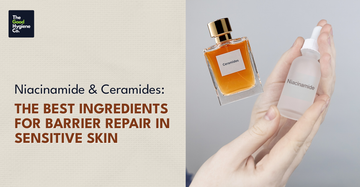If you’ve been struggling with sensitive skin, you probably already know how frustrating it can be. One day your skin feels calm, the next day it’s itchy, tight, or flushed. At the heart of this problem often lies a weakened skin barrier—the protective shield that locks in moisture and keeps irritants out. When the barrier is compromised, your skin becomes more vulnerable to redness, dryness, breakouts, and irritation.
This is where niacinamide and ceramides come in—a pair of ingredients often called the dynamic duo of barrier repair. Used together, they not only restore your skin’s resilience but also strengthen it against future sensitivity.
Understanding the Skin Barrier
Your skin barrier, also known as the stratum corneum, is made up of corneocytes (skin cells) surrounded by a lipid matrix of ceramides, cholesterol, and fatty acids. Think of it as a brick wall—cells are the bricks, and the lipids are the mortar holding everything together.
When this barrier is healthy:
- Moisture stays locked inside.
- Irritants, allergens, and pollutants stay out.
- Skin feels soft, calm, and resilient.
When it’s damaged:
- You may experience tightness, burning, itching, or stinging.
- Conditions like eczema, rosacea, and acne can worsen.
- Everyday products suddenly cause irritation.
The goal of any sensitive skin routine is simple: repair and protect the barrier. And that’s exactly where niacinamide and ceramides shine.
What is Niacinamide and Why is it Good for Sensitive Skin?
Niacinamide, also known as Vitamin B3, is a water-soluble vitamin that has become a star in modern skincare. It’s widely researched and offers a unique set of benefits for sensitive, irritated, or reactive skin types.
Benefits of Niacinamide for Sensitive Skin:
1. Barrier Support
Niacinamide boosts the production of ceramides and fatty acids in the skin, naturally enhancing barrier strength.(1)
2. Redness Reduction
Its anti-inflammatory properties help calm irritation and reduce visible redness, making it ideal for rosacea-prone skin.(2)
3. Oil Regulation
Niacinamide balances sebum production, which is helpful for sensitive skin that is also acne-prone.(3)
4. Soothing Hydration
It helps the skin retain moisture, improving hydration levels without being heavy or greasy.
5. Universal Tolerance
When used in appropriate concentrations (around 2–5%), most sensitive skin types can tolerate niacinamide without irritation.
Also read: Top 7 Incredible Niacinamide Benefits for Your sensitive skin
Can sensitive skin tolerate niacinamide?
Yes—sensitive skin can usually tolerate niacinamide very well, especially at lower concentrations. If you’re just starting, begin with products containing 2–5% niacinamide to minimize any risk of tingling or mild flushing. Over time, as your skin adapts, you can use slightly higher strengths if needed.
What are Ceramides and Why are They Essential for Barrier Repair?
Ceramides are naturally occurring lipids that make up around 50% of the skin barrier. When your ceramide levels drop—due to aging, over-cleansing, harsh weather, or certain skin conditions—your barrier weakens.
Adding ceramides in skincare is like filling cracks in a wall with fresh cement. They restore the structure of your barrier and improve its ability to lock in hydration.
Benefits of Ceramides for Barrier Repair:
1. Moisture Retention
Ceramides prevent water loss, keeping your skin plump and hydrated.
2. Strengthening Barrier Function
They repair gaps in the skin’s protective layer, making it more resilient to external irritants.(4)
3. Soothing Sensitive Skin
Because they mimic natural skin lipids, ceramides are incredibly gentle and rarely cause reactions.
4. Long-Term Protection
Consistent ceramide use helps maintain barrier health, preventing recurring sensitivity.
Why Niacinamide and Ceramides Work Better Together
While both ingredients work beautifully on their own, the real magic happens when you combine niacinamide and ceramides:
- Niacinamide boosts ceramide production internally, while topical ceramides replace what’s missing externally.
- Together, they deliver faster, more comprehensive barrier repair.
- This synergy makes the skin less reactive, calmer, and more resistant to environmental stressors.
Think of it as giving your barrier both tools to rebuild itself and ready-made materials for instant patchwork
How do niacinamide and ceramides help repair my skin barrier?
They repair your skin barrier in complementary ways. Niacinamide signals your skin to produce more natural ceramides and lipids, strengthening the barrier from within. At the same time, applying ceramides topically replenishes what’s already depleted, filling gaps in the barrier immediately. Used together, they reduce water loss, calm irritation, and restore skin’s natural resilience.
How to Use Niacinamide and Ceramides in Your Routine
Sensitive skin doesn’t need a 10-step ritual—what it needs is the right ingredients used in the right order. Since niacinamide and ceramides are both essential for barrier repair, here’s a simple, effective routine built around them:
1. Start with a Gentle Cleanser
Use a mild, sulfate-free cleanser to remove dirt and impurities without stripping your skin. Over-cleansing can worsen barrier damage, so stick to a soft, non-foaming formula.
2. Apply a Niacinamide & Ceramide Serum
After cleansing, go in with The Good Skin Soothing Serum. It’s designed to be both a treatment and a moisturizer in one, making it ideal for sensitive skin.
- Niacinamide calms redness, supports natural ceramide production, and reduces irritation.
- Flax seed oil, jojoba oil, and sunflower oil deliver natural ceramides that strengthen the barrier and lock in hydration.
- Natural allantoin heals irritated skin while gently smoothing rough patches.
- Flower waters and aloe vera juice refresh and soothe, giving lightweight hydration.
Because it combines humectants, emollients, and ceramides, this serum is often enough on its own—no extra moisturizer needed.
3. Finish with Sunscreen (Morning Only)
Sensitive skin is more prone to sun damage, so always apply a broad-spectrum sunscreen after your serum during the day. At night, your serum can be the last step.
Tips for Sensitive Skin Using Niacinamide & Ceramides
- Patch Test First – Apply new products on a small area to check for tolerance.
- Avoid Over-Exfoliation – Harsh scrubs and acids can undo all your barrier repair efforts.
- Combine with Other Soothing Ingredients – Ingredients like hyaluronic acid, allantoin, or panthenol pair well with this duo.
- Stay Patient – Don’t expect overnight results; barrier repair is gradual.
Common Myths About Niacinamide & Ceramides
Myth 1: Niacinamide causes flushing in all sensitive skin types.
Not true. Flushing usually occurs with very high concentrations (10%+), and even then, it often subsides as the skin adjusts.
Myth 2: Ceramides are too heavy for oily skin.
Modern formulations use lightweight ceramides that absorb easily, even in oily or acne-prone skin.
Myth 3: You only need these ingredients if your skin is damaged.
Prevention is better than cure. Even if your skin feels fine now, niacinamide and ceramides strengthen it against future sensitivity.
Who Should Use Niacinamide and Ceramides?
This combination is suitable for:
- People with sensitive or reactive skin
- Those dealing with eczema, rosacea, or acne
- Anyone with dry, flaky, or tight skin
- People living in polluted cities or harsh climates
- Aging skin that has lost natural ceramide production
Conclusion
When it comes to skin barrier repair, very few ingredients are as powerful—or as gentle—as niacinamide and ceramides. One works internally to encourage natural repair, while the other provides external reinforcement. Together, they create a balanced, resilient, and calm complexion.
If you’re tired of dealing with unpredictable sensitivity, consider building your skincare routine around this dynamic duo. With consistent use, you’ll notice fewer flare-ups, better hydration, and stronger, healthier skin overall.
References:
1. Niacinamide and its impact on stratum corneum hydration and structure - 2025 Feb - https://pmc.ncbi.nlm.nih.gov/articles/PMC11811021/#:~:text=These%20findings%20can%20be%20connected,hydration%20process%20via%20DVS%20measurements.
2. Nicotinic acid/niacinamide and the skin - 2004 Apr - https://pubmed.ncbi.nlm.nih.gov/17147561/#:~:text=It%20is%20possible%20to%20demonstrate,on%20skin%20prone%20to%20acne.
3. Mechanistic Insights into the Multiple Functions of Niacinamide: Therapeutic Implications and Cosmeceutical Applications in Functional Skincare Products - 2024 Mar - https://pmc.ncbi.nlm.nih.gov/articles/PMC11047333/#:~:text=As%20concerns%20sebaceous%20activity%2C%20several,86%2C87%2C88%5D.
4. Ceramide AD™ Restores Skin Integrity and Function following Exposure to House Dust Mite - 2023 May - https://pmc.ncbi.nlm.nih.gov/articles/PMC10252232/#:~:text=Ceramides%20are%20lipids%20naturally%20present,)%20%5B11%2C12%5D.






